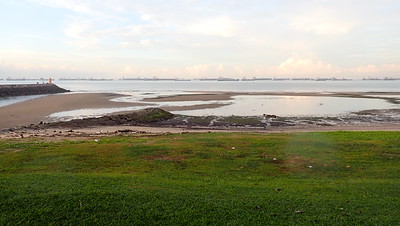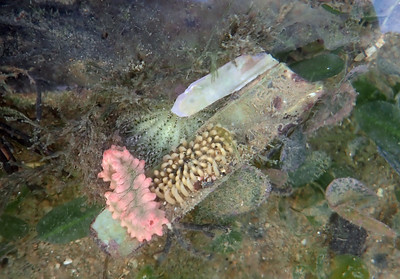 |
| Lights on the horizon are ships parked off the coast. |
Similar to my last survey in Aug 2022 and May 2021, I saw a good variety of corals and I didn't see any that were bleaching. Most seemed very healthy, although a few had large dead patches. Most of the corals were those commonly seen on our shores: delicate folded Disk corals, squat Pore boulder corals and Anemone corals, and other boulder shaped Merulinid corals. But I also saw some less commonly seen ones like Cauliflower coral.
It's a little challenging taking photos of corals in the dark. Kelvin helps light up the huge patch of Branching montipora corals (now about 5m x 5m) for Ilyda to photograph. While Che Cheng shared with her a 'Nemo' Clown anemonefish in a Giant carpet anemone.
One of the nicest patch of seagrasses in Singapore is at the mouth of this canal at East Coast Park! Almost all the seagrass species for Singapore can be found here. And they grow very lush and healthily, green and fresh without much epiphytes, leaves long and not cropped. As in the past, I saw Spoon seagrass (large and small leaves); Needle seagrass (broad and narrow leave); Noodle seagrass; very long Sickle seagrass; Smooth ribbon seagrass; Serrated ribbon seagrass and lots of Tape seagrass with long leaves. Many of the Tape seagrasses had developing female flowers. Unfortunately, today I didn't see many animals among the seagrasses.
The canal drains into a calm bay surrounded by seawalls. Corals have settled near the seawalls.
A special find today: a beautiful Fire anemone (don't touch) and our first time seeing a Peacock-tail anemone shrimp living in one. These shrimps are commonly seen in other large sea anemones.
I left early to walk to the shore in front of NSRCC. Meanwhile, the team had more amazing sightings, including the rarely seen Japanese bonnet snail, two small Knobbly sea stars, two Common sea stars, a Sea Apple sea cucumber. Here's Kelvin's great shot of the reefy corner of the lagoon, and Che Cheng's gorgeous sunrise view of the seagrasses at the mouth of the canal and lagoon. Links to the teams photo albums below.
 |
| Montage of photos by the rest of the team. Links to their albums below. |
The sand bar south of the canal seems a little shorter and wider than it used to be. Creating more pools nearer the high shore. There was a heron hunting in a pool while I was there.
Lush seagrasses are growing well in rather large dense patches. There were Spoon seagrass with large leaves, and Needle seagrass with broad leaves and narrow leaves. I saw very few animals, these are commonly seen in our seagrass meadows: Thorny sea cucumber, Pink warty sea cucumber, small White sea urchins and a small Haddon's carpet anemone.
White sea urchins often 'carry' things, believed to help shield them from the sun as well as camouflage. This urchin was carrying shells of a dead razor clam on which drills had laid egg capsules. And a Thorny sea cucumber was hitching a ride too.
Signs on the sand hint at the life that teems beneath. The most abundant animal visible on the sand bar are Cake sand dollars. They dot the sand in the hundreds. There were also small patches of living Button snails, just beneath the sand surface, leaving typical dots on the sand. I also saw lots of Weasel olive snails, common Moon snails and one Spiral babylon snail. There were also many coils of 'processed sand' left by very long buried Acorn worms.
Where did these corals come from?
The babies of these corals are from Singapore reefs! This chart shared in the Long-Term Plan Review shows coral larvae (babies) dispersal in our waters from mass coral spawning. This highlights the importance of protecting our 'mother reefs' so that they can continue to produce babies that settle all along our shoreline.
What is the fate of these shores?
These shores lie west of Tanah Merah Ferry Terminal and are slated for massive reclamation outlined recently in the Long-Term Plan Review.
Natural regeneration on Singapore's artificial shores and structures is already happening now. Unintentionally, with zero replanting. Can we plan coastal works to allow reefs, mangroves and seagrasses to naturally regenerate? Naturalise canals leading to the sea for a continuum of freshwater wetlands to mangroves? Imagine what's possible! Reefs and natural marine ecosystems at our doorstep, for all in the City to enjoy. More about this idea in my feedback to the Draft Master Plan 2013.
The Singapore Blue Plan 2018
Check out the Sinapore Blue Plan 2018 which outlines community recommendations for all these shores. DOWNLOAD the Plan, SUPPORT the Plan! More on the Singapore Blue Plan 2018 site.
See these and other East Coast shores for yourself
It's fun and easy to explore these shores. Here, Che Cheng is showing Ilyda how an Olive burrows so quickly into the sand. More details in East Coast Park - Surprising intertidal adventures for the family
Photos by others on this survey
Kelvin Yong
Che Cheng Neo
Tommy Arden













